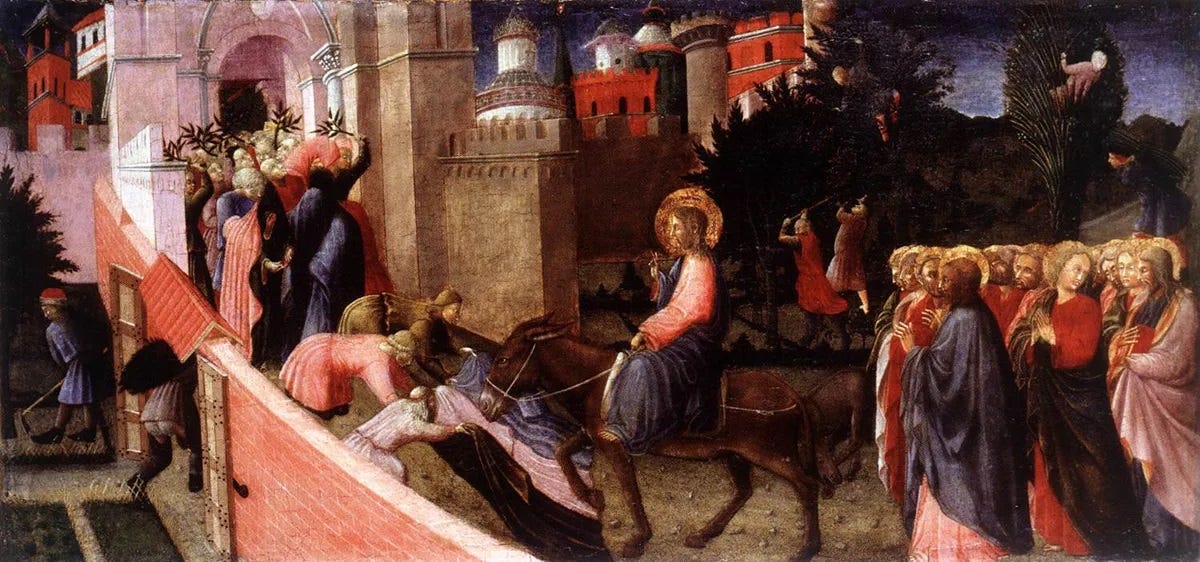What now seems like a lifetime ago, I used to be the unofficial coordinator of liturgical music for the Spanish Mass at a parish in Dubuque, Iowa where my wife was then the Hispanic Minister. Palm Sunday was always one of my favorite Sundays to plan for because of the dramatic shift in tone from the beginning of the liturgy to the end. I would always pair the opening reading, which describes Jesus’ triumphant entry into Jerusalem, and the procession in which congregants wave palms with an upbeat, rhythmic song praising God, and then end the Mass with a song emphasizing our need for God’s mercy.
The dramatic scope of the Palm Sunday liturgy—opening with the celebratory entry but then culminating in the Passion narrative in the Gospel reading—really is remarkable, perhaps only surpassed by the grand sweep of the Easter Vigil. On Palm Sunday, we experience a stunning reversal in Jesus’ reception in Jerusalem. Historically, theologians have noted the contrasts and parallels between the two Gospel readings given on Palm Sunday. Consider these reflections from a sermon by St. Bernard of Clairvaux:
How different the cries, “Away with him, away with him, crucify him,” and then, “Blessed is he who comes in the name of the Lord, hosanna, in the highest!” How different the cries are that now are calling him “King of Israel” and then in a few days’ time will be saying, “We have no king but Caesar!” What a contrast between the green branches and the cross, between the flowers and the thorns! Before they were offering their own clothes for him to walk upon, and so soon afterwards they are stripping him of his, and casting lots upon them.
Contemporary biblical scholarship enriches our understanding of this reversal. The Gospel of Mark, which is the source for Sunday’s reading, and the Gospel of Matthew both suggest that Jesus’ disciples mistook him for a political Messiah who would overthrow the Roman occupiers. The crowds gathering to greet Jesus as he enters Jerusalem, filled with the expectations of such a Messiah, give him a royal welcome, identifying his royal Davidic lineage. After the cleansing of the Temple, however, the Sanhedrin set out to have Jesus killed, and after his arrest, the crowds turn against him, as dramatized in Sunday’s Gospel.
It might be a mistake, however, to treat Jesus’ reception when he enters Jerusalem as a case of mistaken identity. For example, St. Bernard sees Jesus’ entry into Jerusalem as a foreshadowing of his triumphant entry into glory after his Resurrection. And after all, as the Gospel account makes clear, Jesus himself appears to have planned for his entry to be royal in character. Like a king, he has his disciples requisition his means of transport, and choosing an animal on which no one had sat was also a royal prerogative. The choice of a donkey as his steed, however, was a sign that he came in peace, rather than riding into the city on a war horse. Similarly, the Gospel writers show how Jesus’ entry was the fulfillment of prophecies uttered by the Hebrew prophets centuries earlier and not merely a misunderstanding on the part of the crowds.
Pope Benedict XVI, in his Jesus of Nazareth: Holy Week, goes even further. He suggests that the crowd that greeted Jesus when he entered Jerusalem and the crowd that condemned him at his trial should be considered two separate groups. The former were pilgrims coming to Jerusalem to celebrate the Passover, much like Jesus and his disciples were. Many of these pilgrims had likely heard of Jesus’ deeds and teachings, and they were excited to see him coming to Jerusalem to celebrate with them. Benedict turns to Matthew’s description of the city-dwellers’ reaction to the tumult: “When he entered Jerusalem the whole city was shaken and asked, ‘Who is this?’ And the crowds replied, ‘This is Jesus the prophet, from Nazareth in Galilee’” (21:10-11, NAB).
Benedict’s interpretation makes sense, although it runs counter to the liturgical practice of having the congregation voice both those welcoming Jesus and the crowd which condemns him, a practice which emphasizes the parallelisms highlighted by St. Bernard of Clairvaux. By suggesting the crowd of disciples had already correctly identified Christ as the Messiah, it also sits in uneasy tension with, although is not incompatible with, the Markan and Matthean focus on the disciples’ failure to understand Jesus’ mission until his Resurrection.
Although theologians and biblical scholars have proposed a range of interpretations of Jesus’ entry into Jerusalem and its relationship to Christ’s subsequent Passion, the Palm Sunday liturgy puts in stark relief the complexities of Jesus’ identity as the Messiah. It also dramatizes the tendencies latent within each of us Christians to proclaim our faith in Jesus, or perhaps an idolatrous image of him, in moments of enthusiasm, but to turn away from the crucified savior when we are called to take up our own cross.





